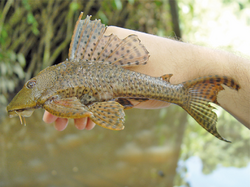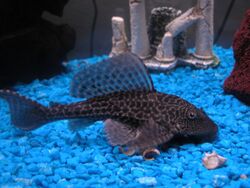Biology:Hypostomus plecostomus
| Hypostomus plecostomus | |
|---|---|

| |
| Picture of an individual from the Commewijne River Basin, published along with the 2012 revision of the Hypostomus plecostomus type series[1] | |
| Scientific classification | |
| Domain: | Eukaryota |
| Kingdom: | Animalia |
| Phylum: | Chordata |
| Class: | Actinopterygii |
| Order: | Siluriformes |
| Family: | Loricariidae |
| Subfamily: | Hypostominae |
| Tribe: | Hypostomini |
| Genus: | Hypostomus |
| Species: | H. plecostomus
|
| Binomial name | |
| Hypostomus plecostomus | |
| Synonyms[2] | |
|
Acipenser plecostomus Linnaeus, 1758 | |
Hypostomus plecostomus, also known as the suckermouth catfish or the common pleco, is a tropical freshwater fish belonging to the armored catfish family (Loricariidae), named for the longitudinal rows of armor-like scutes that cover the upper parts of the head and body (the lower surface of head and abdomen is naked soft skin). Although the name Hypostomus plecostomus is often used to refer to common plecostomus sold in aquarium shops, most are actually members of other genera.[3][1]
Suckermouth catfish are of little or no value as a food fish, although they are at least occasionally consumed over their native range.[citation needed] A demand exists for them, however, as a bottom cleaner in the aquarium trade.[4]
Distribution and habitat
This species' native range is tropical northeastern South America; it naturally occurs in northeastern Brazil , the Guianas, and Trinidad and Tobago.[5] Confusingly, the name Hypostomus plecostomus (or Plecostomus plecostomus) has sometimes been incorrectly used for several more-or-less similar loricariid catfishes, both in the popular and scientific literature. For example, it has sometimes been suggested that it occurs in southern Central America, but this is an entirely separate species, Hemiancistrus aspidolepis (also known under another synonym, Hypostomus panamensis).[6][7]

Some Loricariidae species have been widely introduced to several countries around the world and reported as H. plecostomus.[5] It is erroneous,[1] and the concerned species belong to the genus Pterygoplichthys (either P. pardalis,[8] P. disjunctivus,[9] P. anisitsi[10] or P. multiradiatus[11]). In the United States, a Pterygoplichthys species has been introduced to some regions in the South, most likely released by aquarists into the local waters. For example, they are present in a lake in the neighborhood of Hammock Trace Preserve in Melbourne, Florida. In Texas, reproducing populations occur in spring-influenced habitats of the San Antonio River (Bexar County), Comal Springs (Comal County), San Marcos River (Hays County), and San Felipe Creek (Val Verde County), as well as in drainage canals in the Rio Grande Valley and Houston.[12][13]
The same identification issues have spread in the literature regarding the invasive catfishes in Taiwan, with H. plecostomus being one of the numerous names used to designate the species: DNA studies showed the alien fishes were actually P. pardalis and P. disjunctivus (that hybridise extensively).[14]
H. plecostomus prefer to live in water between 72 and 86 degrees Fahrenheit (~22.2 to 30 degrees Celsius), with a pH between 6.5 and 7.5.[15]
Diet
Hypostomus plecostomus is named for its sucker-like mouth, which allows it to adhere to a surface, as well as to hold and rasp at food.[16] This omnivorous species feeds on algae, aquatic plants, and small crustaceans.[17][citation needed]
Physiology
Hypostomus plecostomus is one of many species of fish that is able to breathe air. Hypostomus plecostomus relies on its gills for respiration in normal and slightly hypoxic water, and the less oxygen present in the water, the more frequently it surfaces to breathe air.[18] The air is taken to the stomach where the oxygen is absorbed, and the air can be kept in the stomach to increase buoyancy, which may help it to feed on vegetation.[19]
In the aquarium
H. plecostomus is one of a number of species commonly referred to as "plecostomus" or "common pleco" by aquarists. These fish are sold when they are young and small, but they can grow to be a maximum size of 50 centimetres (20 in).[20] In the aquarium, this dark-colored, bottom-feeding, nocturnal catfish is often purchased for its ability to clean algae from fish tanks but also contributes a lot of waste to the nitrogen cycle. They are difficult for other fish to harass, both due to the semi-aggressive nature of the fish as well as its thick armor.[21]
Naming
Common names
A large variety of common names is used to describe H. plecostomus, where plecostomus and the shortened "pleco" are interchangeable in all common names. The names include:
- algae sucker/eater
- pez diablo (devil fish)[22] [23]
- pleco
- janitor fish[24]
- municipal fish – 'ikan bandaraya' in Malay
- suckermouth catfish[24]
- sweeper fish – 'ikan sapu sapu' in Indonesian
- crocodile fish (not to be confused with Papilloculiceps longiceps, which is originally known as the crocodile fish or tentacled flathead)
Taxonomy
The species' scientific name, Hypostomus plecostomus, is derived from the Latin hypo (meaning "under"), stoma (meaning "mouth"), and pleco (meaning "pleated").[citation needed]
Many of the common names used to identify Hypostomus plecostomus are also used for other species, which augments the confusion surrounding H. plecostomus and other Loricariidae such as H. punctatus, Pterygoplichthys multiradiatus and P. pardalis. In 2012, Weber, Covain, and Fisch-Muller showed the type series of Carl Linnaeus was heterogenous and comprised two species: H. plecostomus (for which the authors designate a lectotype) and H. watwata.[1]
See also
- List of freshwater aquarium fish species
References
- ↑ 1.0 1.1 1.2 1.3 1.4 Weber, Claude; Covain, Raphaël; Fisch-Muller, Sonia (2012). [Guianas%20colour.pdf "Identity of Hypostomus plecostomus (Linnaeus, 1758), with an overview of Hypostomus species from the Guianas (Teleostei: Siluriformes: Loricariidae)"]. Cybium 36 (1): 195–227. http://sfi.mnhn.fr/cybium/numeros/2012/361/12-Weber[Guianas]%20colour.pdf.[yes|permanent dead link|dead link}}]
- ↑ Froese, Rainer. "Synonyms of Hypostomus plecostomus". FishBase. http://www.fishbase.org/Nomenclature/SynonymsList.php?ID=3057&SynCode=24692&GenusName=Hypostomus&SpeciesName=plecostomus.
- ↑ "Hypostomus plecostomus". Cat-eLog. PlanetCatfish. http://www.planetcatfish.com/catelog/_species.php?species_id=580#2.
- ↑ Sanders, Jessie. "Suckermouth Catfish Species Profile". DotDash. https://www.thesprucepets.com/suckermouth-catfish-species-profile-5079535.
- ↑ 5.0 5.1 Froese, Rainer and Pauly, Daniel, eds. (2011). "Hypostomus plecostomus" in FishBase. December 2011 version.
- ↑ Bussing, W.A. (1998). Freshwater fishes of Costa Rica. Pp. 160–162. ISBN:978-9977-67-489-6.
- ↑ Angulo, Arturo; Garita-Alvarado, Carlos A.; Bussing, William A.; López, Myrna I. (2013). "Annotated checklist of the freshwater fishes of continental and insular Costa Rica: Additions and nomenclatural revisions". Check List 9 (5): 987–1019. doi:10.15560/9.5.987.
- ↑ Amazon Sailfin Catfish (Pterygoplichthys pardalis) - FactSheet , Nonindigenous Aquatic Species
- ↑ Vermiculated Sailfin Catfish(Pterygoplichthys disjunctivus) - FactSheet , Nonindigenous Aquatic Species
- ↑ Paraná Sailfin Catfish (Pterygoplichthys anisitsi) - FactSheet , Nonindigenous Aquatic Species
- ↑ Orinoco Sailfin Catfish (Pterygoplichthys multiradiatus) - FactSheet , Nonindigenous Aquatic Species
- ↑ Pound, Katrina L.; Nowlin, Weston H.; Huffman, David G.; Bonner, Timothy H. (18 November 2010). "Trophic ecology of a nonnative population of suckermouth catfish (Hypostomus plecostomus) in a central Texas spring-fed stream". Environmental Biology of Fishes 90 (3): 277–285. doi:10.1007/s10641-010-9741-7. http://www.allnaturalpetcare.com/Animal_Nutrition_Research/H_plecostomus-Nonnative_Population_Diet.pdf. Retrieved 31 October 2011.
- ↑ Shafland, P. L. (1976). "The Continuing Problem of Non-Native Fishes in Florida". Fisheries 1 (6): 24. http://md1.csa.com/partners/viewrecord.php?requester=gs&collection=ENV&recid=7900591&q=Hypostomus+plecostomus+florida&uid=791197143&setcookie=yes. Retrieved 31 October 2011.
- ↑ Wu, Li-Wei; Chien-Chin, Liu; Si-Min, Lin (2011). "Identification of exotic sailfin catfish species (Pterygoplichthys, Loricariidae) in Taiwan based on morphology and mtDNA sequences". Zoological Studies 50 (2): 235–246.
- ↑ "Common Pleco Care: Diet, Size, Lifespan, Tank Size…". 11 July 2020. https://www.aquariumsource.com/common-pleco/.
- ↑ "Care Guide for Plecos – The Mighty Armored Catfish". Acquarium Co-Op. https://www.aquariumcoop.com/blogs/aquarium/pleco-care-guide.
- ↑ "Plecostomus" (in en). 2016-04-25. https://nationalzoo.si.edu/animals/plecostomus.
- ↑ Gill morphometry of the facultative air-breathing loricariid fish,Hypostomus plecostomus (Walbaum) with, special emphasis on aquatic respiration, Perna and Fernandes 1996 Fish Physiology and Biochemistry
- ↑ The Transition to Air Breathing in Fishes:: I. Environmental Effects on the Facultative Air Breathing of Ancistrus Chagresi and Hypostomus Plecostomus Loricariidae. 1982 GRAHAM, J. B., & BAIRD, T. A. https://journals.biologists.com/jeb/article/96/1/53/23365/The-Transition-to-Air-Breathing-in-Fishes-I
- ↑ Hypostomus plecostomus (Linnaeus, 1758) Suckermouth catfish - FishBase
- ↑ "Common Pleco Care: Diet, Size, Lifespan, Tank Size…". 11 July 2020. https://www.aquariumsource.com/common-pleco/.
- ↑ "Fish jerky, anyone? Business hopes to sell Mexico's 'devil fish' to Canadians as sustainable snack | CBC News". https://www.cbc.ca/news/technology/invasive-species-mexico-devil-fish-jerky-1.4752176.
- ↑ Orfinger, Alexander Benjamin; Douglas Goodding, Daniel (2018-02-14). "The Global Invasion of the Suckermouth Armored Catfish Genus Pterygoplichthys (Siluriformes: Loricariidae): Annotated List of Species, Distributional Summary, and Assessment of Impacts". Zoological Studies 57: e7. doi:10.6620/ZS.2018.57-07. ISSN 1021-5506. PMID 31966247.
- ↑ 24.0 24.1 Froese, Rainer (5 August 2014). "Common names of Hypostomus plecostomus". FishBase. http://www.fishbase.org/comnames/CommonNamesList.php?ID=3057&GenusName=Hypostomus&SpeciesName=plecostomus&StockCode=3253.
Further reading
- "Don't Dump Your Aquarium in the River!". 2021-11-12. http://www.sariverauthority.org/whats-new/blog/dont-dump-your-aquarium-river.
Wikidata ☰ Q1768403 entry

